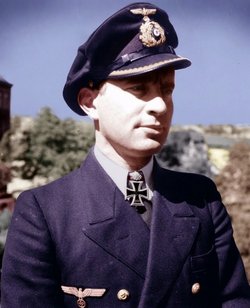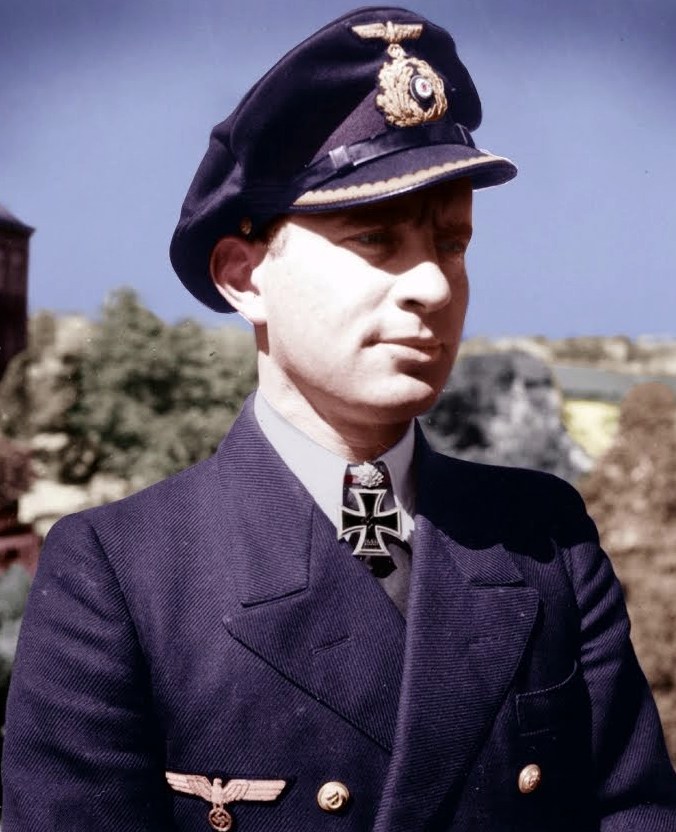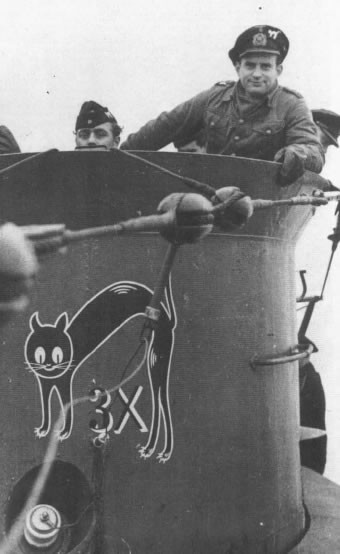On April 5, 1935, the 5'4" Teddy Suhren entered naval training as a line officer trainee, attached to the Second Division of the newly named Kreigsmarine (German Navy). He progressed through his basic military training then moved on to training at sea in the Baltic. He injured his leg and was sidelined for sometime but finished the course nonetheless and was passed on to become a Seekadetten (Sea Cadet) and spent none months on-board the German ship, EMDEN. While on this cruise the ship went to the Azores, Caribbean and through the Panama Canal to the Pacific Ocean. He excelled in all of his training and possibly would have graduated top of his class but was disciplined for a curfew violation which set him back in his class standing. At some point during his training, he acquired the nickname "Teddy" due to the fact he marched "like a Teddy-bear".
Though short in height and not of strict military decorum, Teddy was his own man and an excellent young officer, even though he was verbally reprimanded by Gross admiral Karl Donitz for cursing during gunnery practice. He had chosen the right career. For further reading about Teddy's early naval career, there are several excellent publications, including one by Teddy himself, to do further research.
After completing his training, Teddy was assigned to the U-Boat service and his first submarine, the U-48, in March, 1938 with the slot as First Watch Officer . During his year on the U-48, Teddy fired 65 torpedoes with 30 of them striking their targets and/or sinking the enemy ships. for his superior performance i=on the U-48, he received the Knights Cross of the Iron Cross, Germany's highest award for valor.
In April, 1941, Teddy took command of his own submarine, the U-564. He would become a Kreigsmarine "Ace of Aces" for his superior command of this attack submarine. Counting his service on U-48, he fired more successful torpedo shots than any other man during World War II, both Axis and Allied.
Teddy never joined the Nazi party and like his father, was not prone to follow the rigid doctrine or thought control of National Socialism. He was at times rebellious and somewhat disrespectful of those over him or of the Nazi leaders, but his skills and successes protected him. These skills and successes were evident shortly after the U-564 went to sea on their first patrol.
At 0155 hours on June 27, 1941, the U-564 sited a convoy of ships (convoy number HX-133) U-564. They were about 300 miles south of Iceland. Teddy fired three single torpedoes in one minute intervals at the convoy and hit ships named the MAASDAM, MALAYA II and the KONGSGARRD. The first ship, teh MAASDAM, was struck on teh port side at the #2 hold area and destroyed several of the ships lifeboats but the most of the 48 crew members and 32 passengers survived. In fact, all survived but two passengers, American Red Cross nurses who were part of a group going to England to work in a hospital. There was a contingent of United States Marines on board as well and this may be the only occurrence in World War II that a German submarine sank a merchant ship carrying American Marines. The MAASDAM and the MALAYA II were sunk, and the KONGSGAARD badly damaged (it would return to see only to be sunk by U-67 on February 27, 1942 near Venezuela).
On August 23, 1941 the U-564 sank the British Corvette (small warship) HMS ZINNIA (K-98). At 0421 hours (time is per the ship's captain's after action report), Teddy's boat fired three single torpedoes at ships into a convoy (OG-71) west of Portugal. They claimed to have hit three ships but only the ZINNIA was confirmed; 68 of the 85 officers and crew were killed.
In October 1942, Teddy left the U-564 and became an instructor. Later he served in the 27th U-boat flotilla along with Korvettenkapitän Erich Topp.
During the last year of the war now Fregattenkapitän Suhren was the Commander-in-Chief of U-boats in Norwegian waters.
After the war ended, by nature of his rank, Teddy was held as a prisoner of war until April, 1946. His parents and sister had attempted to escape the Sudtenland but were unable to do so. They committed suicide together in 1945. His older brother Gerd had risen to the rank of Korvettenkapitän himself in the U-Boat service and had also been awarded the Knight's Cross of the Iron Cross.
On May 31, 1953, Teddy was a member of the board of the new German Federal Navy. He lived as an independent businessman in Leichlingen (Rhineland) working int eh petroleum industry. The most successful submarine commander of all time died on August 25, 1984 in Halstenbek.
Reinhard "Teddy" Suhren earned the following badges/decorations for his naval service prior to and during World War II:
- 1939 Iron Cross 2nd Class awarded September 1939
- U-Boat War Badge awarded December 21, 1939
- Iron Cross 1st Class awarded February 25, 1940
- Knights Cross of the Iron Cross awarded November 3, 1940
- Knights Cross with Oak Leaves awarded December 31, 1941
- U-boat War Badge with Diamonds awarded March, 1942
- Knights Cross with Oak Leaves and Swords awarded September 1, 1942
- War Merit Cross 2nd Class with Swords awarded January 30, 1944
On April 5, 1935, the 5'4" Teddy Suhren entered naval training as a line officer trainee, attached to the Second Division of the newly named Kreigsmarine (German Navy). He progressed through his basic military training then moved on to training at sea in the Baltic. He injured his leg and was sidelined for sometime but finished the course nonetheless and was passed on to become a Seekadetten (Sea Cadet) and spent none months on-board the German ship, EMDEN. While on this cruise the ship went to the Azores, Caribbean and through the Panama Canal to the Pacific Ocean. He excelled in all of his training and possibly would have graduated top of his class but was disciplined for a curfew violation which set him back in his class standing. At some point during his training, he acquired the nickname "Teddy" due to the fact he marched "like a Teddy-bear".
Though short in height and not of strict military decorum, Teddy was his own man and an excellent young officer, even though he was verbally reprimanded by Gross admiral Karl Donitz for cursing during gunnery practice. He had chosen the right career. For further reading about Teddy's early naval career, there are several excellent publications, including one by Teddy himself, to do further research.
After completing his training, Teddy was assigned to the U-Boat service and his first submarine, the U-48, in March, 1938 with the slot as First Watch Officer . During his year on the U-48, Teddy fired 65 torpedoes with 30 of them striking their targets and/or sinking the enemy ships. for his superior performance i=on the U-48, he received the Knights Cross of the Iron Cross, Germany's highest award for valor.
In April, 1941, Teddy took command of his own submarine, the U-564. He would become a Kreigsmarine "Ace of Aces" for his superior command of this attack submarine. Counting his service on U-48, he fired more successful torpedo shots than any other man during World War II, both Axis and Allied.
Teddy never joined the Nazi party and like his father, was not prone to follow the rigid doctrine or thought control of National Socialism. He was at times rebellious and somewhat disrespectful of those over him or of the Nazi leaders, but his skills and successes protected him. These skills and successes were evident shortly after the U-564 went to sea on their first patrol.
At 0155 hours on June 27, 1941, the U-564 sited a convoy of ships (convoy number HX-133) U-564. They were about 300 miles south of Iceland. Teddy fired three single torpedoes in one minute intervals at the convoy and hit ships named the MAASDAM, MALAYA II and the KONGSGARRD. The first ship, teh MAASDAM, was struck on teh port side at the #2 hold area and destroyed several of the ships lifeboats but the most of the 48 crew members and 32 passengers survived. In fact, all survived but two passengers, American Red Cross nurses who were part of a group going to England to work in a hospital. There was a contingent of United States Marines on board as well and this may be the only occurrence in World War II that a German submarine sank a merchant ship carrying American Marines. The MAASDAM and the MALAYA II were sunk, and the KONGSGAARD badly damaged (it would return to see only to be sunk by U-67 on February 27, 1942 near Venezuela).
On August 23, 1941 the U-564 sank the British Corvette (small warship) HMS ZINNIA (K-98). At 0421 hours (time is per the ship's captain's after action report), Teddy's boat fired three single torpedoes at ships into a convoy (OG-71) west of Portugal. They claimed to have hit three ships but only the ZINNIA was confirmed; 68 of the 85 officers and crew were killed.
In October 1942, Teddy left the U-564 and became an instructor. Later he served in the 27th U-boat flotilla along with Korvettenkapitän Erich Topp.
During the last year of the war now Fregattenkapitän Suhren was the Commander-in-Chief of U-boats in Norwegian waters.
After the war ended, by nature of his rank, Teddy was held as a prisoner of war until April, 1946. His parents and sister had attempted to escape the Sudtenland but were unable to do so. They committed suicide together in 1945. His older brother Gerd had risen to the rank of Korvettenkapitän himself in the U-Boat service and had also been awarded the Knight's Cross of the Iron Cross.
On May 31, 1953, Teddy was a member of the board of the new German Federal Navy. He lived as an independent businessman in Leichlingen (Rhineland) working int eh petroleum industry. The most successful submarine commander of all time died on August 25, 1984 in Halstenbek.
Reinhard "Teddy" Suhren earned the following badges/decorations for his naval service prior to and during World War II:
- 1939 Iron Cross 2nd Class awarded September 1939
- U-Boat War Badge awarded December 21, 1939
- Iron Cross 1st Class awarded February 25, 1940
- Knights Cross of the Iron Cross awarded November 3, 1940
- Knights Cross with Oak Leaves awarded December 31, 1941
- U-boat War Badge with Diamonds awarded March, 1942
- Knights Cross with Oak Leaves and Swords awarded September 1, 1942
- War Merit Cross 2nd Class with Swords awarded January 30, 1944
Sponsored by Ancestry
Advertisement
Records on Ancestry
Sponsored by Ancestry
Advertisement






